Physical Security and Stockpile Management (PSSM) best practices are identified in the Nairobi Protocol and other SALW regional and international instruments as one of the priority areas in the fight against illicit SALW proliferation. They provide ways for potential improvements to stockpile safety and management. While the quality of practices varies from member state to member state, the
the objective of PSSM interventions is to ensure that weapons will be operational when needed and that only authorized personnel will have access to them.
Thus, the existence of effective procedures and practices to control the trafficking of SALW constitutes an important element in efforts to control the destabilizing accumulation and uncontrolled spread of such weapons. In order to further strengthen the PSSM implementation capacity, RECSA Secretariat has produced this PSSM handbook to act as a simplified practitioners’ guide (reference material) for those charged with the day-to-day storage and safety of stockpiles.
This handbook heavily refers to the International Small Arms Control Standards (ISACS) and the International Ammunition Technical Guidelines (IATGs) but in a simplified version taking cognizance of the existing infrastructure in RECSAmember states. If operationalized, this handbook will be instrumental in improving the capacity of member states to assess stockpiles, Standard Operating Procedures (SOPs), and infrastructure and provide ways of potential improvement to the safety and management of stockpiles.
Finally, I would like to reiterate the commitment of the RECSA Secretariat to promoting and building the capacity of member states in PSSM aimed at controlling diversion and unintended explosions at munition sites. I call upon all those in charge of the safety and management of stockpiles to refer to this handbook in their day-to-day operations.

